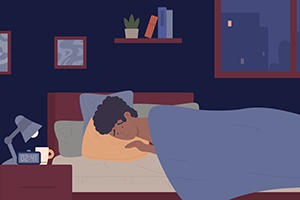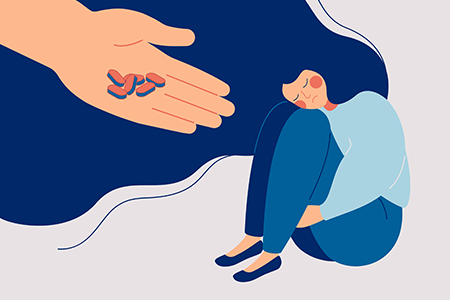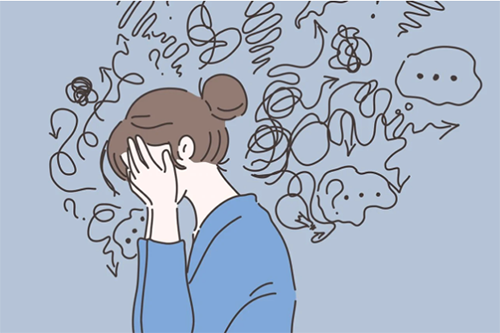
“I’m having trouble sleeping” is a common concern of patients who report co-morbid mental health concerns like anxiety or depression and/or have a history of trauma, but sleep issues can be reported independently of other conditions as well. Though it can be tempting to suggest using melatonin or another medication to aid with sleep, there are simple behavioral interventions that may be just as – if not more – effective in the long-term for addressing sleep-related concerns.
One of the simplest ways to gain a better understanding of what sleep-related concerns our patients are facing is to ask. Is it that they aren’t sleeping as much as they would like to? Are they sleeping too much? Is their sleep interrupted? Asking about environmental factors is important, too. Do they have a new baby at home? Did they recently change jobs? Do the other people in their home sleep on different schedules than they do? Even clarifying what their sleep schedule looks like can help you to decide what to recommend.
Someone can have sleep-related problems that don’t rise to the diagnostic criteria for insomnia, or they may be experiencing primary or secondary insomnia. Once you’ve gathered information about what problems they are encountering, you’ll have a better sense of whether the difficulties are related to sleep onset, sleep maintenance, or early awakening (or some combination). It’s also a good idea to assess for other sleep disorders, not just insomnia. According to the Center for Disease Control, the most common sleep disorders, in addition to insomnia, are narcolepsy, Restless Leg Syndrome, and Sleep Apnea. An important note about sleep apnea – be sure to assess for it even in your patients who are not classified as obese, as apnea may occur in individual with normal or low BMI.
After clarifying what sleep-related difficulties your patient is reporting – and attending to any potential sleep disorders aside from insomnia – it’s a great time to begin talking about sleep hygiene. Consistency is key when it comes to sleep hygiene. Going to bed at the same time every night (when possible, of course) and getting up at the same time each morning can go a long way. Yes – even on non-workdays!
Another important sleep hygiene tip: the bed is for three things – sleep, sex, and sick. It can be tempting to read or watch TV in bed. And who among us hasn’t played on our phones instead of going to sleep? However, maintaining the sanctity of the bed for sleep, sex, and/or sick – and only these three things – encourages strong sleep-bed associations. Something else that encourages strong sleep-bed associations? Getting out of bed within 10-15 minutes of waking or if unable to fall asleep for approximately 15-20 minutes. The longer you are in bed and awake, the weaker your sleep-bed association will be.
Other sleep hygiene tips:
- Avoid napping (unless it’s a safety concern). It can be tempting, especially when someone is very tired, but it ultimately decreases one’s “sleep appetite” and makes it harder to sleep at night.
- Implement a wind-down routine, preferably without screens (TV, phones, computers, etc.). Try to avoid screens for an hour or more before bed.
- Keep your bedroom cool and dark.
- Avoid exercise, eating, or drinking close to bedtime. If someone wakes due to hunger, trying a small snack before bed could help – but it’s best to avoid a large meal.
- Avoid alcohol, cigarettes, and other substances close to bedtime. For those individuals who smoke cigarettes – a gentle reminder that nicotine is a stimulant and therefore counterproductive to sleep can be helpful.
- If waking in the middle of the night, avoid eating, drinking, or smoking. Our bodies become habituated to patterns and if you eat a snack every night at 2:00am, 2:00am may officially become snack time!
- Don’t go to bed unless you’re tired. This might run counter to “consistent bedtime” however, getting into bed just because the clock (but not your body) says it is time can make it harder to sleep.
Individuals who are not able to correct their sleep difficulties with sleep hygiene alone may benefit from completing a course of Cognitive Behavioral Therapy for Insomnia. This treatment typically occurs across 4-8 sessions, though individuals may begin to see positive results in as few as 3 weeks. This treatment can be completed with a trained therapist or via a self-paced online course. CBT-I can be tried before sleep medications and, in many cases, may end up making medication unnecessary.
CBT-I provides education about sleep, sleep hygiene, and helps to identify specific strategies to improve an individual’s sleep. It may involve sleep restriction – the practice of restricting when a person gets into bed and gets up – which helps consolidate sleep into a more solid block. As sleep becomes consolidated (and sleep efficiency improves), more time in bed is added based on individual need and bedtimes/wakeups are adjusted.
One last caveat – if you are seeing a patient who has been diagnosed with ADHD and is reporting sleep-related concerns, you may want to explore the possibility of Delayed Sleep Phase Syndrome (DSPS), in which the sleep/wake phase occurs later than “normal.”
Sleep is extremely important to health – and when we’re not getting enough of it, it shows. Hopefully this information will prove helpful in working with patients with that ever-present concern of, “I’m having trouble sleeping!” You can always call the Psychiatry Consultation Line (877-927-7924) for clinical advice when sleep issues co-present with mental health concerns like anxiety, depression or ADHD as well as assessment, treatment decisions and monitoring of mental health conditions in general. Call us anytime – we are a part of your team!
Author
Koriann Cox, PhD
Acting Assistant Professor, University of Washington School of Medicine, Department of Psychiatry and Behavioral Sciences
Learn More:
UW Psychiatry and Addictions Case Conference series (UW PACC)*
When should I use sleep aids in my patients with sleep disorders… (and when should I not?)
Presenter: Catherine McCall, MD
The objectives of this presentation are to 1) learn about different ways in which insomnia can manifest; 2) understand the pathophysiology of insomnia; and 3) explore different ways to address and treat
insomnia effectively.
Psychological and behavioral treatments for insomnia
Presenter: Katherine Palm-Cruz, MD
The objectives of this presentation are to 1) develop an understanding of psychological and behavioral treatments for insomnia disorder; 2) understand recommendations for first line treatments for chronic insomnia; and 3) appreciate the evidence of how CBT-I compares to pharmacologic treatments for insomnia.
My patient has good sleep hygiene. What should I counsel them to do next to improve their poor sleep?
Presenter: Barbara McCann, MD
The objectives of this presentation are to 1) conduct a 24-hour interview to identify problem areas in need of remediation to address insomnia; 2) identify two broad areas of sleep-interfering cognitions and suggest strategies for dealing with each type; and 3) make use of stimulus control principles to address sleep-interfering behaviors.
*The UW Psychiatry and Addictions Case Conference series (UW PACC) is a free, weekly teleconference that connects community providers with UW Medicine psychiatrists and addictions experts. Sessions include both an educational presentation on an addictions or psychiatry topic and case presentations where providers who participate receive feedback and recommendations for their patients.
Learn More: other resources
- Free CBT-I Information: http://freecbti.com/
- Veterans Affairs CBT-I: https://www.veterantraining.va.gov/insomnia/ (the VA also offers a free app for CBT-I called CBTI Coach)
- Attention Deficit Hyperactivity Disorder and Delayed Sleep Phase Syndrome may be linked, posted on the American Association of Sleep Technologists website
- Sleep and Sleep Disorders: https://www.cdc.gov/sleep/index.html
- American Academy of Sleep Medicine: https://aasm.org/






